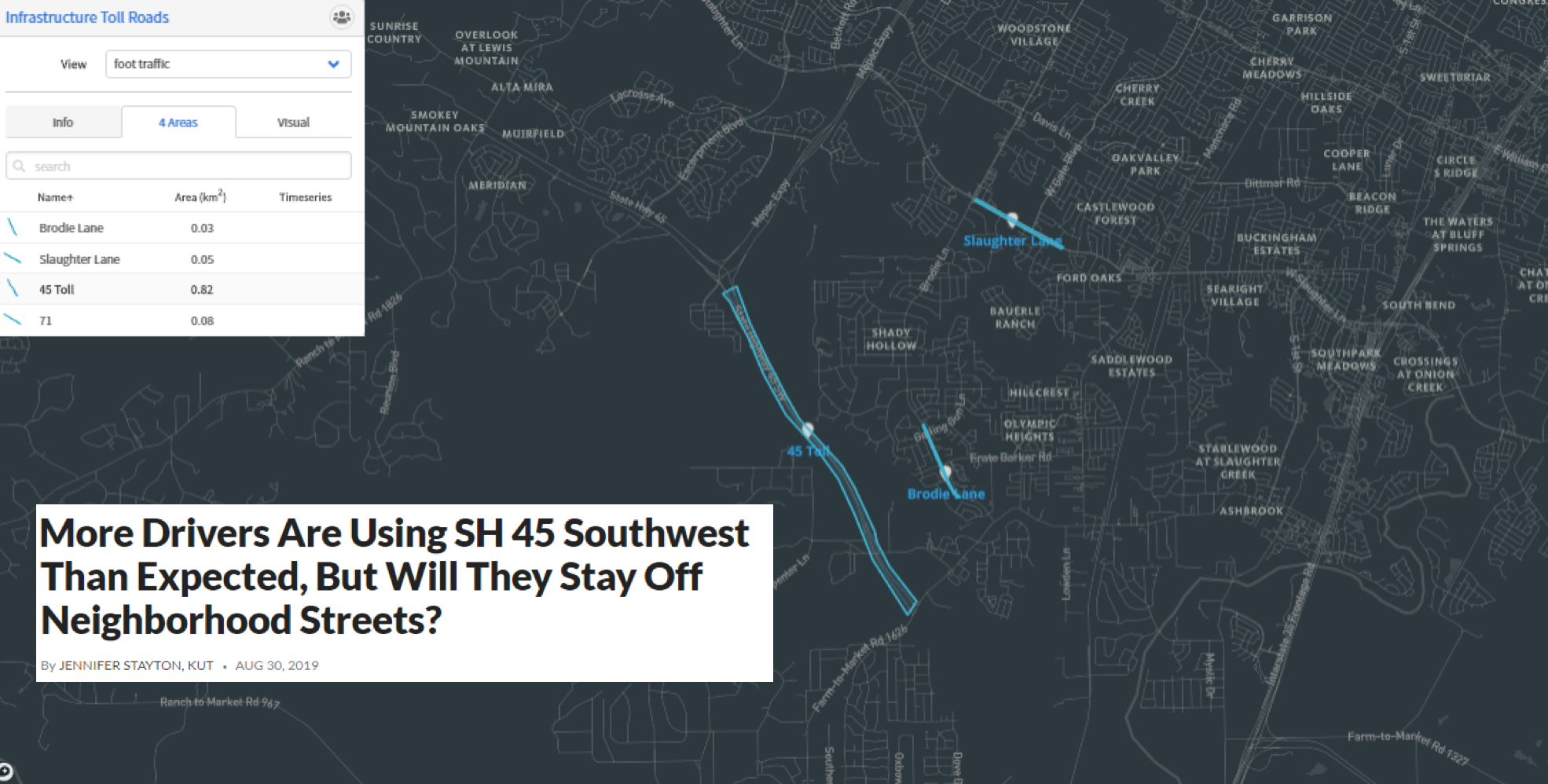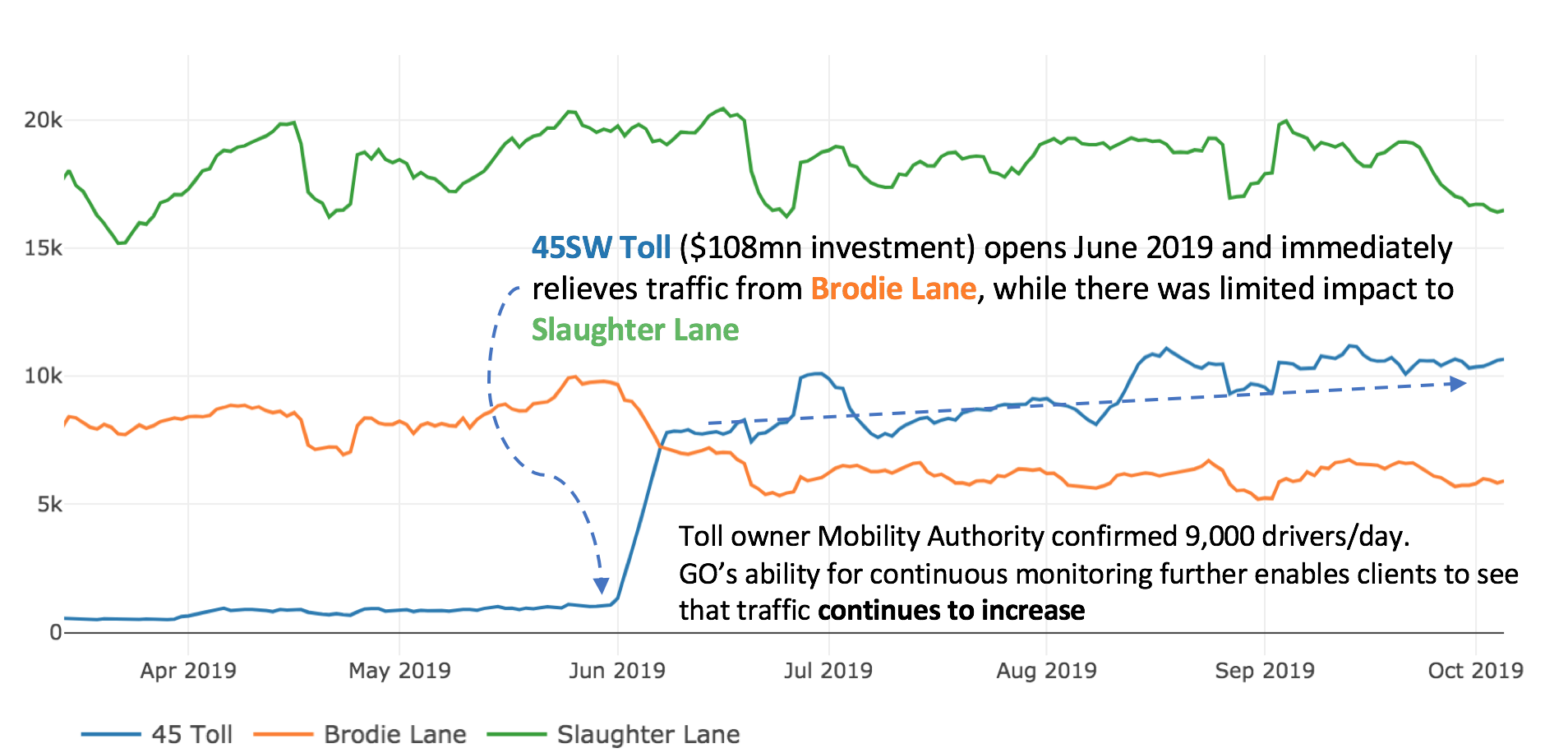- Orbital Insight Blog
- GO Shows Traffic Ramp-Up On New Texas Toll Road & Potential Realty Impact
Blog
GO Shows Traffic Ramp-Up On New Texas Toll Road & Potential Realty Impact
“Build a new highway and rooftops will surely follow."
The Urban Land Institute notes that the correlation between the advent of the interstate highway system and mushrooming of realty projects has made the aforecited saying a universal truth.
What the institute wonders, however, is: how much of this truth applies to tolled highways?
While toll roads are becoming an increasingly popular way to serve transportation needs in fast-growing U.S. metropolitan areas, the extra expense to use such roadways can deter the very drivers who developers hope to lure to subdivisions, shopping centers, and office parks, the institute says.
Orbital Insight’s research shows that in the United State alone, toll revenue accounts for more than $13bn annually across 35 states & 6,000 miles of roadway. Understanding which areas would benefit from additional toll roads (reduced congestion, maximized revenue) with historical scenario & quantifiable impacts can help federal and state governments and investors determine which projects to create and invest in.
The Urban Land Institute finds that actual development trends along newer U.S. toll roads are decidedly mixed. In metropolitan areas where toll roads have been built in high-growth corridors — and where they constitute the only highways built recently — the tollways have been a magnet for real estate investment. But in metropolitan areas where toll roads have been built in low-growth corridors and in competition with free highways, the tollways have usually struggled to attract interest from developers.
In Austin, next to Round Rock is Pflugerville, a bedroom community that doubled in population between 2000 and 2006, when the area’s first toll road, which runs right through the town, opened, setting off a wave of commercial construction. A Walmart and a movie theater opened; a shopping center with a Home Depot and a Target was developed at a toll road exit. As a result, the city’s sales tax revenues have jumped 10 percent every year since 2007, the Urban Land Institute notes.

Orbital Insight also has a more positive example from its study of the Texas 45SW Toll, which connects the Loop 1 freeway on the west side of Austin with the southern Travis and northern Hays county. The $108 million toll road — named Mopac Expressway after the adjacent Missouri Pacific Railroad — successfully steered traffic away from the neighborhood Brodie Lane that used to serve as key connection between the Loop 1 freeway and the Travis-Hays counties.
GO, our geospatial-driven data which does vehicle counts and other activity tracking in any designated Area of Interest (AOI), shows immediate traffic relief from the congested Brodie Lane as drivers moved to the Mopac upon its opening on June 2019 opening. Mopac operator Mobility Authority correspondingly confirmed 9,000 drivers a day on the new tolled road. Logically, there could be one reason for the ramp-up: As Mobility Authority explains there are no toll booths on the Mopac, meaning drivers continue moving along, paying either by an electronic tag or bills sent in the mail.

New toll roads can have a significant impact on retail and businesses in their vicinity, as well as the suburbs they connect. GO’s ability for continuous monitoring of the Mopac will enable clients to see virtually in real-time traffic growth on the road. For realty developers and their investors, and the planning and budgetary agencies of local, state and federal agencies, our data could be crucial for due diligence and other scenarios analysis.
New infrastructure projects, including toll roads, have a major impact on traffic flows. Understanding how that shifts, and the positive/negative impacts on one neighborhood versus another can have a considerable impact on commercial real estate prices/leasing costs as well as opportunities for retail site selection given more or fewer potential customers.
While traditional traffic studies can cost tens of thousands of dollars over an extended period of time, Orbital Insight GO allows users to create quick, accurate, and efficient data to monitor infrastructure projects within hours.
For more information on gaining activity-based insights using GO, please reach out to: support@orbitalinsight.com








